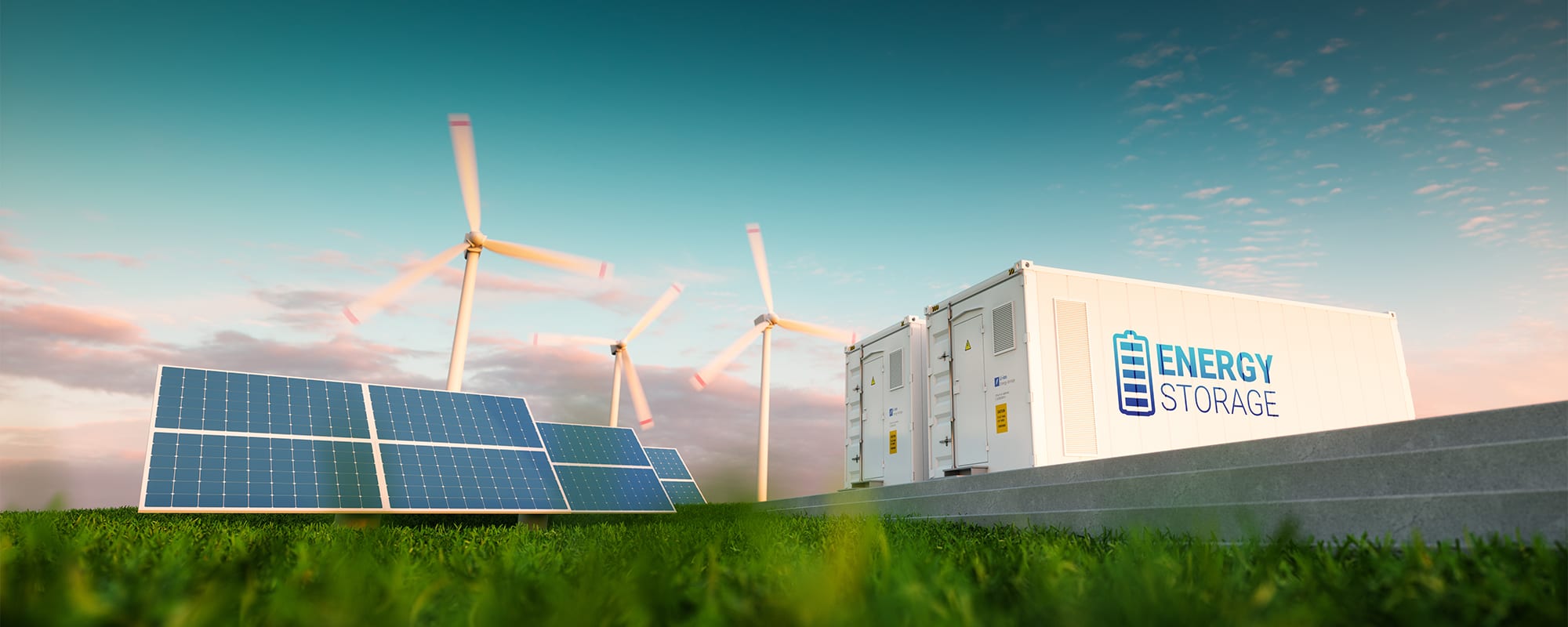We spoke to Jesus Saiz, Industry Sales Manager for Battery Energy Storage Systems and EV Charging Infrastructure at TE Connectivity, to learn more about the American renewable energy industry, BESS and EV charging applications, and 11 enabling components essential to the continued evolution of this fast-paced industry.

In recent years, global interest in renewable energy has significantly increased. Impediments to adoption — including the consistency of weather-related energy sources, like the sun and the wind, and the speed, efficiency, and availability of EV charging systems — are rapidly being overcome with technological solutions. We spoke to Jesus Saiz, Industry Sales Manager – Battery Energy Storage Systems, EV Charging Infrastructure, and Semiconductor Manufacturing Equipment, at TE Connectivity, to learn more about the American renewable energy industry, BESS and EV charging applications, and enabling components essential to the continued evolution of this fast-paced industry.
Tell us a little about the current renewable energy market in the U.S.
The American renewable energy market is largely driven by government initiatives and incentives. Those aimed at boosting solar and wind power generation will help mitigate disturbances to the power grid, provide power during traditional grid outages, and reduce customers’ bills. Those aimed at encouraging electric vehicle (EV) adoption will help decrease CO2 emissions and satisfy national and global commitments to reducing greenhouse gasses and lessening the effects of climate change.
Initiatives like the Build America, Buy America (BABA) Act, which requires that all iron, steel, manufactured products, and construction materials used in infrastructure projects that receive federal financial assistance — including renewable energy infrastructure like solar and wind power generation and distribution facilities and EV charging networks — be produced in the U.S., are giving American manufacturers preferential opportunities as well as encouraging global players, like LG Energy, to set up shop in the U.S.
Industry giants including Tesla and ChargePoint currently dominate the American EV charging market, but initiatives like these are helping to fund startups and other innovative companies that can help shape and further accelerate the rapidly evolving renewable energy industry and help the government reach its sustainability goals.
In fact, thanks in large part to government initiatives and incentives, the U.S. renewable energy market is expected to grow at a compound annual growth rate (CAGR) of 10.01% from 2023 to 2028, which is really saying something given that the value of the U.S. renewable energy market that TE Connectivity served in 2022 was about $270 billion. This steady growth is expected to boost national green energy generation from 395 gigawatts to 636.44 gigawatts annually.
In addition, the global renewable energy market was valued at $1.1 trillion in 2022 and projected to grow at a CAGR of 16.9% from 2023 to 2030. So, these federal initiatives and incentives also improve the global competitiveness of American renewable energy products.
What are battery energy storage systems, and why are they essential for renewable energy applications?
Battery energy storage systems, or BESS, are rechargeable battery systems that can store energy from different sources and deliver it when it’s needed. They can help stabilize the power grid by balancing out load-related inconsistencies, provide critical backup power, and compensate for times of low energy production to ensure consistent access. As such, BESS are used to support various power generation, power transmission, and power consumption applications, including solar inverters, power conversion systems, and battery backup systems, and are widely used in the power utility, industrial manufacturing, 5G, hospital, data center, and residential housing industries.
When used in conjunction with renewable power generation, demand-side integration, smart power grid, IIoT, and new energy technologies, BESS can also help enable a greener, smarter, and more interconnected energy market. Deployments like these are already in place and expanding rapidly and are expected to make a significant difference in the renewable energy market by 2030.

You mentioned a few different BESS applications. Can you tell us more?
BESS are widely used in renewable energy applications including central solar inverters, string solar inverters, power conversion systems, and battery systems.
Central Solar Inverters are large, typically floor- or ground-mounted power inverters used to convert DC power generated by solar panels into AC power so it can be used by homes or businesses or connected to the power grid. Today’s central solar inverter manufacturers are looking to cut costs, support smart grid features, and standardize monitoring and control interfaces to maximize efficiency and improve reliability. TE Connectivity and other electronics manufacturers support these manufacturers with enabling components including compact and high-reliability off-board power resistors, terminal blocks, DC contactors, and electromagnetic interference (EMI) filters.
String Solar Inverters are also used to convert DC power generated by solar power into AC power capable of being used in homes and businesses or connected to the grid. These inverters, which are usually mounted on a wall or other structure, are connected to multiple solar panels via “strings,” which makes the power delivery performance equal to that of the worst performing panel. Today’s string solar inverter manufacturers are looking to integrate monitoring tools, including sensors, and other advanced, smart-grid-compatible features that will improve their efficiency and help them function as energy management centers. Enabling components include compact, powerful, and highly dependable signal relays, EMI filters, passive resistors, and power relays.
Power Conversion Systems (PCSs) control the charging and discharging of battery systems, allow battery systems to convert stored DC energy into transmissible AC energy, and enable the large-scale utilization of renewable energy sources, energy storage systems, and microgrids. Enabling components include DC contactors, pre-charge and off-board resistors, EMI filters, terminal blocks, and panel-plug-in (PPI) relays.
Battery Systems are complete energy storage systems that play a key role in renewable energy success by helping to balance renewable energy supplies with electricity demands. Today’s manufacturers are being challenged to deliver higher duty cycles, longer lifespans, and greater power storage capabilities. To that end, they are leveraging new thermal management technologies and an array of compact, proven-safe and -reliable component including advanced switches, connectors, DC contactors, off-board power resistors, terminal blocks, and EMI filters.
Please introduce some essential component solutions for BESS applications in the renewable energy industry.
Power and Signal Connectors: The increasing digitalization of BESS products has increased the demand for reliable power and signal connectivity. Signal connectors enable the efficient transmission of voltage, while power connectors enable the efficient transmission of amperes. Key characteristics of power and signal connectors designed for use in BESS applications include compact, cost-effective, and halogen-free form factors, high-reliability performance, high heat dissipation capabilities, and ratings up to 500V and 20A. TE Connectivity’s M8 and M12 power and signal connectors and CPC Series circular plastic connectors are great examples, and are both widely used in solar battery management systems.
Power Relays: Power relays open and close circuits using an electromagnetic coil to provide a seamless flow of power. Key characteristics of power relays designed for use in BESS applications include small form factors, high current switching capabilities up to 40A, large-pitch contact spacing for high dielectric strength and reliability, low temperature rise, maximum operating temperatures of at least 85°C, and UL, VDE, and TUV certifications. TE’s OJS Series power relays and PCFN power relays are great examples, and both are widely used in string solar inverter applications.

Signal Relays: Signal relays are electrically operated electromechanical switches used to control the flow of current in a circuit. They are similar to power relays, but they’re designed to handle low current, typically under 2A, and switch low power signals typically rated for 5–30VDC. Key characteristics of signal relays designed for use in BESS applications include small form factors, energy-saving low coil power consumption, switching current ratings of 2–5A, switching power ratings of at least 60W/62.5VA, and high dielectric and surge capabilities up to 2,500Vrms between open contacts and the coil and contacts. TE’s Axicom Signal Relays are a great example and are widely used in string solar inverters, energy control units, and liquid cooling solutions.
DC Contactors: DC contactors are electrically controlled devices used to open and close internal contacts in DC circuits to switch the current on and off. They’re designed to control much lower voltages than AC circuits and to minimize arcing as the circuit opens and closes. In BESS applications, they support unit control, power distribution, and main switch functions. Key characteristics of DC contactors designed for use these applications include hermetic sealing, current ratings spanning 50–350A, auxiliary contact monitoring capabilities, low power consumption, maximum breaking voltage ratings of at least 900VDC, and high switching capabilities up to 1,500VDC. TE’s ECK Series is a great example.
Other components essential to BESS applications in the renewable energy industry include passive resistors, which provide current limitation, voltage division, and circuit protection.
I read that improvements in BESS designs are driving down the cost of battery production and making renewable energy more accessible on a global scale. How so?
- Lithium-ion batteries are becoming less expensive, which helps to reduce BESS costs.
- Higher BESS station voltages — typically 1,500V vs. 1,000V — are improving power densities and system efficiency and reducing system costs in applications with battery management systems (BMSs) that can also withstand 1,500V.
- Increased battery cell capacities enabled by improvements in battery consistency and more precise BMSs deliver higher power densities and reduce the overall size of battery racks, opening the door to applications with more stringent space restrictions.
- Shorter design cycles of a year and a half or less better support existing equipment upgrades and new renewable energy application demands.
Tell us a little about the current EV charging market in the U.S.
The EV charging market in the U.S. is focused on developing and installing infrastructure that’s energy-efficient, sustainable, cost-effective, fast-charging, standardized, flexible, safe, and small.
There are currently three levels of EV charging in the U.S.
- Level 1, residential AC wall outlets, provide a full charge in 12 hours.
- Level 2, residential or public AC charging stations, provide a full charge in 2–3 hours.
- Level 3, DC public charging stations, provide an 80% charge in 20–30 minutes.
Level 1 and Level 2 EV charging solutions are economical and support flexible installations, while Level 3 EV charging solutions offer the fastest charging capabilities.
There are currently more than three million EVs on the road and over 130,000 public charging stations across the country, and the U.S. government is funding efforts to further accelerate the buildout of a convenient and reliable national EV charging network.

Please introduce some essential component solutions for EV charging applications.
Enabling components for Level 1 and Level 2 EV chargers include power relays, board and signal connectors, power resistors, switches, filters, and electrical solutions, and ideal solutions will utilize space wisely, deliver high performance, and ensure safety.
Enabling components for Level 3 EV chargers include DC contactors, board and signal connectors, power resistors, switches, filters, terminal blocks, and other electrical solutions capable of handling high power, current, and temperature over long lifetimes.
Power Relays: As mentioned when discussing BESS components, power relays open and close circuits using an electromagnetic coil to provide a seamless flow of power. In Level 1 and 2 AC EV charging applications, they’re often used for the main switch function. Key characteristics of power relays designed for use in these applications include compact form factors, high current, voltage, and temperature ratings, high switching capabilities, proven safety features, long lifetimes, and energy-saving features. TE’s T92 power relays and T9V power relays are great examples. The T92 series has a small form factor with reinforced insulation, the T9V Series supports switching up to 40A and can replace traditional AC contactors, and they both deliver high-reliability performance.
Board and Signal Connectors: Board and signal connectors are available in a wide variety of form factors designed to enable wire-to-board signal and power connections and board-to-board or wire-to-board signal connections. Key characteristics of board and signal connectors designed for use in EV charging applications include small, cost-effective form factors, quick and easy installation, high electrical reliability, reliable signal transfer performance, low maintenance requirements, vibration and corrosion resistance, and safety features. TE’s AMPMODU and AMPMODU MTE connectors, Dynamic 1000, 3000, and 5000 connectors, and Micro-MaTch connectors are great examples of board and signal connectors ideal for use in AC and DC EV charging systems.
AMPMODU MTE connectors offer latching and polarization features and are available in a high-temperature surface-mount variant. The Dynamic series are designed to safely and reliably transmit signal in harsh environment applications, help meet miniaturization requirements, and are available in a wide range of current ratings and pin counts. They are also well suited for use in solar battery management systems. Micro-MaTch connectors have a unique spring contact system that prevents corrosion by absorbing movement between contacts and is also well suited for use in string solar inverter applications.
Electrical Solutions: Electrical solutions including terminals, splices, wire labeling and identification products, heat shrink tubing, cable glands, and wire ducts are also essential for EV charging applications. Terminals and splices designed for these applications should provide high reliability and long lifetimes in harsh environment conditions. Wire identification solutions should come in a wide range of colors, configurations, and sizes well suited for indoor and outdoor environments. TE’s SOLISTRAND terminals, PIDG terminals and splices, which are compatible with high-speed assembly processes, wire labeling and identification solutions, and heat shrink tubing are all well suited for use in AC/DC EV charging applications.
Other TE Connectivity components ideal for use in AC/DC EV charging applications include SQ Series resistors and Corcom three-phase power filters.
You mentioned that a few of the enabling components for EV charging systems —TE’s Dynamic Series and Micro-MaTch connectors — were also well suited for use in BESS applications. Are there any other components that typically satisfy the needs of both BESS and EV charging applications?
Power Resistors: Power resistors dissipate energy by converting it to heat and are used to maintain stable circuit performance under heavy loads and manage thermal conditions. They tend to be larger than other types of resistors and designed for higher loads, typically over one watt, and are widely used in automotive, railway, industrial, and power applications. Power resistors in BESS and EV charging applications are often used for pre-charge, discharge, and brake functions. Key characteristics of power resistors designed for renewable energy applications include high pulse resistance, high power density (up to 25 times the standard power rate for short-time overload), space savings without sacrificing power, high voltage resistance, high reliability, and high heat dissipation capabilities.
TE Connectivity is a leading supplier of standard and custom power resistors and offers an extensive range of high-quality wire-wound power resistors with compact aluminum housings proven to deliver excellent reliability and stability and effectively dissipate high power in a limited space with low surface temperatures. Our HS resistors, which are ideal for use in central solar inverters, solar power conversion systems, solar battery management systems, and AC/DC EV charging, are an excellent example and are available in variants rated for 5–300W.
Terminal Blocks: Terminal blocks are modular blocks with clamping components, conducting strips, and insulated frames that provide semi-permanent connections for two or more wires and help to simplify field inspection and repair processes. Key characteristics of terminal blocks designed for use in renewable energy applications include compact, modular form factors that support easy installation and flexible employment, durability in harsh environments, safety, and reliability.

TE offers a variety of terminal blocks, including ENTRELEC and ENTRELEC SNK Series terminal blocks, which are ideal for use in central solar inverter, solar power conversion system, and AC/DC EV charging applications, and ENTRELEC DBL power distribution blocks, which are ideal for use in all of those applications in addition to solar battery management systems. TE’s SNK Series terminal blocks have high-density screw-clamp designs with a locking pin feature that makes them 50% faster to install than competing terminal block and top markings for higher visibility. ENTRELEC DBL power distribution blocks distribute electrical circuits from a single point to several devices, have a compact form factor, are easy to install and configure, and are available with current ratings extending from 80–500A.
EMI Filters: EMI filters suppress electromagnetic noise transmitted through current conduction while allowing desirable currents to flow freely. Key characteristics of EMI filters designed for use in renewable energy applications include high-performance filtering, flexible assembly, small form factors, and compatibility with UL, CSA, and VDE standards. TE’s Corcom EMI Filters are a great example and are ideal for use in central solar inverters, string solar inverters, solar power conversion systems, solar battery management systems, and AC/DC EV charging applications.
Anti-Vandal Switches: Anti-vandal switches are rugged panel-mount pushbutton switches typically made of metal and found in high-use application areas including traffic crossings, door entry systems, and renewable energy applications. Key characteristics of anti-vandal switches designed for BESS, solar battery management, and EV charging applications include robust form factors, ease of use, LEDs, waterproof sealing, piezo and capacitor functionality, and safety shutoff features.
TE Connectivity and RS – Enabling the Evolution of Renewable Energy
TE Connectivity designs and develops advanced component technologies engineered to support the continued evolution of renewable energy applications, including solar and wind power generation, energy storage, EV charging, and high-voltage control cabinets. We offer an extensive range of solutions proven safe and effective in these applications and continue to add new products to our renewable energy portfolio to keep up with the industry’s fast-paced innovations and enable a more sustainable future. Trusted channel partners like RS, which supplies a wide variety of our renewable energy industry solutions, help us provide customers with comprehensive support spanning the component selection, procurement, installation, and maintenance phases.
For more information about TE Connectivity’s BESS solutions, please visit our BESS landing page, this video, and our BESS Product Solution Guide. For more information about our EV charging solutions, please visit our EV charging landing page, this video, and our EV charging Product Solution Guide and request a virtual sample kit.
For more information about the RS portfolio of TE Connectivity products, including components ideal for use in BESS and EV charging applications, please visit the links embedded throughout this article. For assistance identifying, procuring, deploying, and maintaining component solutions essential for renewable energy applications, please contact your local RS representative at 1.866.433.5722 or reach out to the RS technical product support team.







